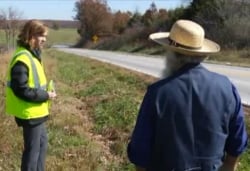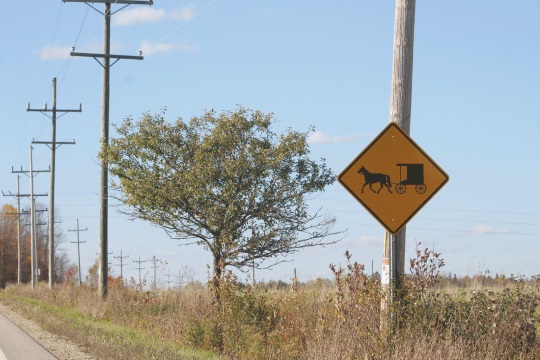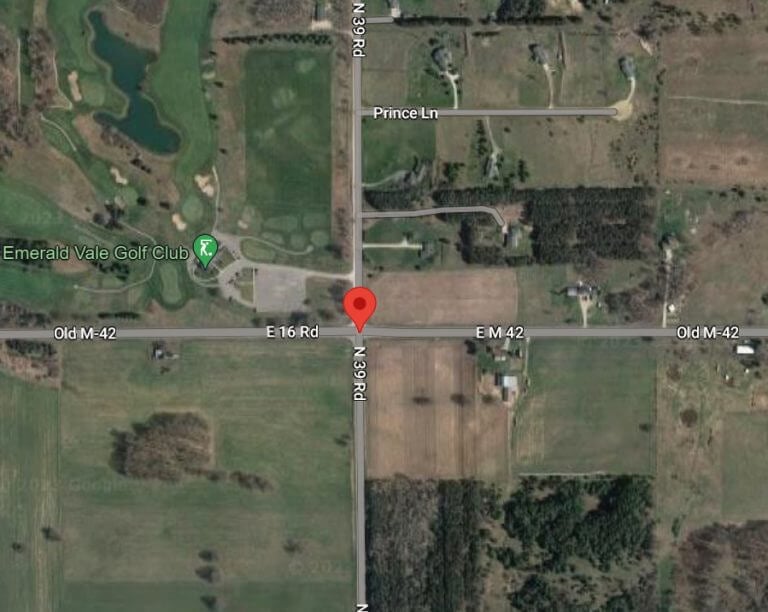How much should be done to improve buggy safety?
Webster County, Missouri Amishman Emanuel Schwartz shares his road safety concerns with a news station in this video. Schwartz would like the Missouri DOT to create more buggy pull-offs on a dangerous stretch of highway. These are particularly important in hilly areas or on curves where visibility is poor.
Amish take into account road traffic when founding a new community. However that is just one of many factors that enter into the decision. The Webster County Amish settlement (also referred to as the Seymour community, after the name of a nearby town) has been around since the late 1960s. Since that time the county’s population has more than doubled. Schwartz notes there are now more buggies and cars traveling busy Highway 38, where a number of Amish homes are located.
This story made me wonder how much is spent to enhance safety for the relatively tiny horse-and-buggy population (though such enhancements should also mean a safer experience for automobile drivers who share those roads). If I had to guess? I’d suspect the total sums are not great compared to other road and highway expenditures.
 Some improvements are more costly than others. Putting up a yellow buggy warning sign is relatively cheap (at least, I hope it’s cheap). Widening roads and adding lanes takes a lot more in money and time. A study investigating the per-capita expenditures and benefits of different projects would be worthwhile.
Some improvements are more costly than others. Putting up a yellow buggy warning sign is relatively cheap (at least, I hope it’s cheap). Widening roads and adding lanes takes a lot more in money and time. A study investigating the per-capita expenditures and benefits of different projects would be worthwhile.
States have to make investment decisions based on budgets which are by definition limited. If project A gets funded that may mean project B does not. Why one project goes forward and another does not has to do not only with the finances available but also things like feasibility and public pressure.
And that brings us to the second reason this story is interesting. It’s reported Schwartz was actually the one who contacted the news station about his concerns. Normally these “Amish” stories originate from the other direction.
So here we see Amish turning to a media they typically avoid, to help publicize an issue, and one would assume, to garner public support and awareness. This is not common, though not unprecedented. For example, a couple of years ago Amish in Geauga County, Ohio brought a news crew along to film what it’s like to travel by buggy with cars whipping by at high speed.
My conclusion is that Schwartz must be especially concerned to take this step. The Geauga County video was made after a buggy was hit from behind and a pregnant women died. Perhaps Schwartz does not want to wait for something that tragic to happen.
In the video, the soft-spoken, Southern-drawled Amishman is careful to only appear filmed from behind, of course. I wonder if his appearance will have the effect he desires.






Which taxpayer funds typically go toward road repairs and improvements (besides the Wheel Tax)? Do the Amish contribute to these taxes? I think that pull offs every mile or so would be beneficial to everyone. Just knowing that there’s one coming up usually helps automobile drivers find some extra patience. I believe that the Amish would gladly pay towards this improvement. (Sorry if these questions/thoughts were covered in the video, I couldn’t watch it.)
Amish and road taxes
My understanding is that federal fuel tax tacked onto gas and diesel primarily funds federal roads. I don’t know what each state does to fund state-level roads; my home state of NC collects a highway use tax which comes into play when vehicle titles are transferred. This might vary by the state.
It’s probably a safe guess that Amish don’t buy nearly as much fuel as non-Amish even with their use of diesel for generators, etc. Amish might counter the criticism that they don’t pay enough for roads by saying they pay large sums of property tax but many don’t send their children to public schools. I think Roberta’s comment below touches on the problems with trying to divvy up a given taxpayer’s right to have a say in each issue based on what he/she specifically contributes and takes from the system.
I wouldn’t be surprised if Amish in this situation would be willing to contribute for the improvements, and might do well to offer to do so at least as a symbolic sign of goodwill. Amish in other communities have expressed such willingness in similar situations. For example Illinois enacted a license law for buggies whose purpose was to raise money for roads. Amish were quoted as being willing to chip in to pay, though they weren’t excited about toting the plates.
http://articles.chicagotribune.com/2002-07-23/news/0207230199_1_donald-b-kraybill-buggies-amish-life
One church bishop declined to discuss the matter, saying it is not the business of outsiders. But several Amish residents in town for business this week said that if the fee helps to make the roads better, it is worth their money.
“We all can come up with $50,” one said.
“We’re obligated to help pay for the roads,” said Levi Schrock, who works at the Four Acre Wood Products shop outside town. “I don’t think it’s outrageous.”
Those who disagree are reluctant to say so. Discord has been subtle.
All Federal spending on highways since the Interstate system was created until 2010 was fully funded by motor vehicle fuel taxes.
The highway portion of Obama’s stimulus bill simply accelerated how fast money was being spent from the Highway Trust Fund…so by 2010 general government revenue was needed.
It’s not entirely his fault, either. Our current No New Taxes mentality has meant Federal and most state gas taxes have remained at the same fixed cents per gallon since the early 1990s, despite all the inflation that has taken place since then. A much more sane solution would be a sales tax like rate that would’ve expanded revenue as gas prices went up.
25% of Federal gas taxes and many states are diverted right off the top to non-highway related transportation spending like mass transit and bike lanes.
Every state I’ve ever looked at the budget details for, the state revenue collection from motor vehicles in the form of gas taxes, registrations, sales taxes, etc. exceed what they spend on highway construction and maintenance.
There is a strongly held myth in some political segments that roads are heavily subsidized by general government revenue, but while I can take any state budget and show they’re paying for themselves and then some…the folks who believe in the myth at best will resort to Enron like accounting maneuvers where they’re just spinning fantasies you can’t see on paper, or change to the subject how there are other non-financial costs like the environmental impact.
There was a kernel of truth to that belief — it wasn’t until the late 50s/early 60s that fuel taxes really took over as the primary funding mechanism. Before then general taxes and tolls played a much larger role. And if we don’t fix our fiscal disaster of a house soon, we’ll end up back in that same place again.
I haven’t studied it on a local level, but I do know for my town of 8,500 that our Public Works budget (mostly highways, but they do any other grunt work needed like helping out with heavy maintenance at the parks) is equal to what we collect in property taxes on automobiles…so they balance each other out. I suspect that holds true in many areas.
Thanks for this Matt. Did not realize it was a fixed cents-per-gallon tax as you note. Though come to think of it the sign on the pump does tell you xx cents of the price is federal tax, which isn’t a %. Would only make sense that that revenue would fall behind pace. Though wow, 25% seems a lot for mass transit and bikes. Outside of big cities I am just skeptical as to how far these two forms of transport will go in the United States of Car-Driving America.
I think that the drivers of the vehicles should have a little respect. They don’t but they should. Most people driving vehicles don’t pay attention to the “school” signs much less the “buggy” signs. If people would slow down and use a little common sense there wouldn’t be a need for this.
Safe Driving in Amish Country
We’ve had more than our share of buggy rides here in the Michiana region, and I can tell you that it’s pretty nerve-wracking to have a car or truck whip by at highway speeds while you’re poking along at 15 miles per hour. The roar of the vehicle, the wind, and the rocking of the buggy is enough to give buggy occupants the willies, let alone the horse pulling the buggy.
This past summer we sat down with our Amish friends and wrote up a list of safe driving tips for driving in Amish country. Go here to learn more:
http://www.amishworkshops.com/among-the-amish/how-to-drive-in-amish-country.html
Great post
Great post today, Erik. Ok, I’m a little biased in that this is my home state 🙂
After reading your post, I feel that you’ve done as much or more research as the news story did.
As my aunt is one of many who share or compete for the road in this area of Missouri, I think that the English feel that they are as patient as they can be already. And as we can see from the video, in many areas there is no shoulder for anyone, buggy or vehicle, to move to.
I’m so glad Mr Schwartz got past the Amish need for privacy to campaign for more pull-off areas. Mr Edwards from MoDoT is a reasonable good man who will definitely work to see if something can be accomplished to the benefit of all.
Thanks Carolyn. My prediction is that they will get something done here. I think the message humbly sent by Schwartz as representative of the Amish will make an impression (people realize getting on TV is not a typical or comfortable thing for Amish to do). And sounds like there might be willingness on the other side as well.
1. I pay all the taxes that apply to me so I get a say in how the government spends the money they have collected and it seems to me that the Amish should get the same. If we are going to start itemizing then, since I have no kids, I would be extremely happy to stop voting in school elections if you let me stop paying school tax.
2. The English in some places are certainly NOT as patient as they can be already. If I drive anywhere near the posted speed limit sooner or later I will get tail-gated, lights flashed at me, and horn honked until they can pass while giving me the finger. And I’m driving a Honda, not a horse.
I wonder if the “pull over” areas are so greatly “engineered” that Amish men ould not contribute to building them with their own labor as well as some finances???
That’s a novel idea Elizabeth…I don’t know how much technical know-how is needed to construct such pull-offs…the greater obstacle, I sense, is that red tape and regulations would probably shut down any idea of say Amish workers doing the job in their off time.
Maybe not so novel.
Erik, apparently this use to be quite common. The old timers often used their work horses and mules to pull the (animal powered)road graders. My understanding is that each little community would have the grader brought in and they would turn out on a given day to grade the roads for so many miles out in each direction from their community.
Of course, everything was gravel back then and since the vehicles were light the roadbed didn’t need to be quite as stout as what is required for today’s roads. They did this rather than pay road taxes. Maybe what’s old will be new again.
I suppose society did used to be more “Amish” in the sense that these local community-driven initiatives were more common. Maybe old will be new again, though I am generally pessimistic 😉 Thanks for sharing this Oldkat.
Mark's opinion
I read this post to my son, Mark, who is Amish. He mentioned that every family in the Belle Center Amish community have, for a number of years, donated $25 per buggy, voluntarily, to the Logan County Engineer for road maintenance. Actually, I knew about that, too, because it was a front page article in the Bellefontaine Examiner newspaper a couple of months back. For once I knew about something in the Amish community without Mark telling me. As I remember it, the County Engineer was quoted as saying the Belle Center Amish contributed almost $6,000 in voluntary road tax per year. Mark said he feels that this is just and right.
Belle Center Amish road contributions
Don, nice example, thanks for sharing it. And nice that you were able to beat Mark to the line for once! If I’m not mistaken I think I saw that paper on Mark’s kitchen counter when I visited this summer.
Parallels in the English world
I thought this was, upon reading the headline, about safety improvements that could be made in buggy design. Still, my thought on that angle remains the same, although perhaps over simplified. I thought:
“It might not be fair, but an Amish buggy is a bit like an English bicycle, what can be done to improve its safety? Very little actually; it seems to me that the safety factor is based more on the mindset of the owner and, also the courtesy of, those who share the road with it, both a bicycle and a carriage”
Apples and oranges, as they say, but I think it is something, a comparison, non-Amish can comprehend. Am I way off here?
Safety trade-offs
I think concerning safety improvements on these vehicles, you are about right Shom. I trust that the makers of buggies and bicycles are generally going to do the best job they can to make their vehicles more safe, within the constrains of reality.
It’s a fact that we have to make trade-offs involving safety, money, and comfort. We could all wear helmets when riding in cars, for example, like race car drivers. It would be safer but most people wouldn’t want to put up with the discomfort. But as we further attempt to remove the risk from every human activity perhaps there will be a law one day requiring helmets ;0 My feeling is that you have to find a “sweet spot” and accept that there will always be some risk in anything we do.
We should cover the obvious and reasonable things though, and going back to the above story, if this Amishman is going to put himself on TV out of his concern, I hope the local authorities will listen and do what is within their power to get some gravel pull-offs where it is possible. In other words I doubt this is a frivolous worry.
I sometimes wonder what the Amish will look like in a hundred years. Will the old order Amish be able to hold onto the old ways or will they assimilate into modern society? I am sorry to go off topic but this post demonstrates a Amish man willing to turn to a media outlet in order to call attention to a situation, which could mean he is willing to step out from behind the curtain and utilize a powerful modern means in the media as a tool. I only mention this because as a whole it appears the old order are becoming more and more comfortable with association with modern society. The Amish in Lancaster is a good example of the Amish culture being heavily influenced by the outside society. Sorry for the ramble Erik, perhaps this comment is better set for another post.
Tom I didn’t think this a ramble at all. Interesting question, and a good place to ask it.
Amish in 100 years
I think the Amish will change, but very very slowly. I grew up near Amish settlements and my ancestors were Old Order Amish. When I was a girl (1970’s), the Amish men near us carried pocket watches. The Amish women near us wore small gold or silver plain pocket-style watches pinned to their dresses. Over the last 25 years or so,, they have begun wearing plain, Timex-style wristwatches instead. Most of the women/girls have switched from heavy black oxford style shoes to plainer styles of tennis shoes.
Katrina I’ve never heard of Amish wearing wrist watches as they are generally considered taboo (like jewelry)…would these be horse-and-buggy Amish or a different group?
Good to see "common ground"...
How brave of Mr. Schwartz to bring this obvious hazard to light. The same can be said of the MoDot representative, who clearly agrees there’s a hazard and seems willing to help alleviate it. Two reasonable men, seeking a solution to a problem that may ultimately save lives. Compromise, sacrifice…their example should be held up to all the politicians up for election/re-election a few days from now.
I can dream, can’t I?
Alice Mary
Just read about another buggy accident in NW Wisconsin. The hit and run semi driver was eventually arrested.
http://www.startribune.com/local/176833371.html?refer=y
When approaching a buggy from the rear at nighttime, the carriages are more visible if they have a row of blinking red lights along the top, such as they have in Lancaster County. Blinking lights or reflective tape along the top edge of the rear side is especially helpful when a vehicle comes over a hill. The carriage can be seen earlier than when only a Slow Moving Vehicle emblem is displayed at a lower level. Many buggies also have taillights for safety.